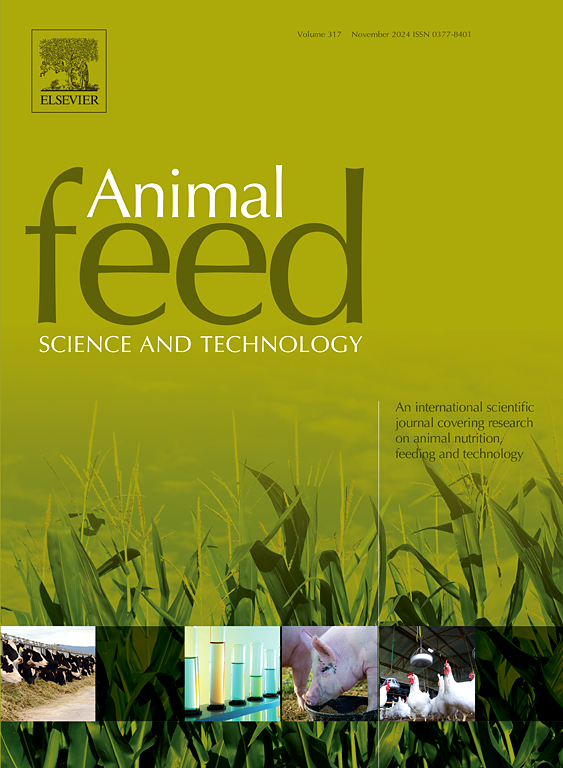Dietary cholesterol promotes the growth of mud crabs, Scylla paramamosain by regulating cholesterol metabolism, enhancing ecdysteroid synthesis and molting cascade response
IF 2.5
2区 农林科学
Q1 AGRICULTURE, DAIRY & ANIMAL SCIENCE
引用次数: 0
Abstract
A seven-week feeding trial was conducted to evaluate the effects of dietary cholesterol on growth, proximate composition, cholesterol metabolism, ecdysteroids synthesis and molting cascade response in mud crab (Scylla paramamosain). Six isonitrogenous and isolipidic diets (46 % protein and 11 % lipid) were formulated to contain graded levels of cholesterol, with the analyzed levels of cholesterol being 0.15 %, 0.32 %, 0.54 %, 0.72 %, 0.91 % and 1.53 %, respectively. A total of 180 crabs (initial weight 16.26 ± 0.02 g) were separated into six treatments, each treatment dividing randomly into three replicates of 10 crabs. The results showed that crabs fed the diets with 0.54 %-0.91 % cholesterol displayed significantly higher FW, PWG, SGR and FE than those fed the diet with 0.15 % cholesterol. The hepatopancreas lipid content of the crabs with dietary 1.53 % cholesterol was significantly higher than that of the crabs without dietary cholesterol supplementation. Compared to crabs fed the diet with 0.15 % cholesterol, significantly higher concentrations of ApoA, HDL-C, LDL-C, VLDL-C in serum and ApoA, HDL-C in hepatopancreas were observed at crabs fed the diet with 0.72 % cholesterol. The highest concentrations of 20E and MF in serum were observed at crabs fed the diet with 0.72 % cholesterol, whereas the concentration of MIH in serum was significantly lower in crabs fed the diets with 0.72 % and 0.91 % cholesterol than those fed the diets with 0.15 % and 1.53 % cholesterol. The expression levels of genes related to cholesterol metabolism (srb, ldlr, lrp2, cyp27a1 and start3) in hepatopancreas were significantly higher in crabs fed the diet with 0.54 % cholesterol than those fed the diet with 0.15 % cholesterol. The expression levels of molting-related genes (nvd, dib, rxr, br-c, e74b, e75, ftz-f1, met) were significantly higher in crabs fed the diet with 0.54 % cholesterol than crabs fed the diet with 1.53 % cholesterol. The highest expression level of ecr was in 0.72 % and 0.91 % cholesterol group. With dietary cholesterol increasing from 0.15 % to 1.53 %, the expression levels of mfe and jheh significantly decreased, whereas the expression levels of famet and hr38 significantly increased. In conclusion, 0.54 %-0.72 % cholesterol promoted cholesterol metabolism and activated expression levels of molting-related genes, leading the better growth performance of mud crabs. Based on PWG and the R-Square (R2) of the equations, two equations of the linear truncated model (Y = 45.98X + 57.562 and Y = − 33.312X + 112.31) were used to calculate the optimal cholesterol requirement of 0.68 % for juvenile mud crabs.
膳食胆固醇通过调节胆固醇代谢、增强蜕皮类固醇合成和蜕皮级联反应促进泥蟹的生长
为了评估日粮胆固醇对泥蟹(Scylla paramamosain)生长、近似成分、胆固醇代谢、蜕皮类固醇合成和蜕皮级联反应的影响,进行了一项为期七周的饲养试验。研究人员配制了六种等氮和离脂日粮(46 % 蛋白质和 11 % 脂质),其中胆固醇含量分级,分析的胆固醇含量分别为 0.15 %、0.32 %、0.54 %、0.72 %、0.91 % 和 1.53 %。总共 180 只螃蟹(初始重量为 16.26 ± 0.02 克)被分为六个处理,每个处理随机分为三个重复,每个重复 10 只螃蟹。结果表明,饲喂胆固醇含量为0.54%-0.91%日粮的螃蟹的FW、PWG、SGR和FE显著高于饲喂胆固醇含量为0.15%日粮的螃蟹。日粮中添加1.53%胆固醇的螃蟹的肝胰脏脂质含量明显高于未添加胆固醇的螃蟹。与饲喂 0.15 % 胆固醇的螃蟹相比,饲喂 0.72 % 胆固醇的螃蟹血清中载脂蛋白 A、HDL-C、LDL-C、VLDL-C 的浓度以及肝胰脏中载脂蛋白 A、HDL-C 的浓度明显更高。血清中 20E 和 MF 的浓度在胆固醇含量为 0.72 % 的膳食中最高,而血清中 MIH 的浓度在胆固醇含量为 0.72 % 和 0.91 % 的膳食中明显低于胆固醇含量为 0.15 % 和 1.53 % 的膳食。胆固醇代谢相关基因(srb、ldlr、ldp2、cyp27a1和start3)在肝胰腺中的表达水平,饲喂胆固醇含量为0.54%日粮的蟹明显高于饲喂胆固醇含量为0.15%日粮的蟹。蜕皮相关基因(nvd、dib、rxr、br-c、e74b、e75、ftz-f1、met)在胆固醇含量为0.54%的饲料中的表达水平明显高于胆固醇含量为1.53%的饲料。ecr在胆固醇含量为0.72%和0.91%组的表达水平最高。随着膳食胆固醇从0.15%增加到1.53%,mfe和jheh的表达水平显著下降,而famet和hr38的表达水平显著上升。总之,0.54%-0.72%的胆固醇能促进胆固醇代谢,激活蜕壳相关基因的表达水平,从而提高泥蟹的生长性能。根据PWG和方程的R-Square(R2),利用线性截断模型的两个方程(Y = 45.98X + 57.562和Y = - 33.312X + 112.31)计算出幼体泥蟹对胆固醇的最佳需求量为0.68%。
本文章由计算机程序翻译,如有差异,请以英文原文为准。
求助全文
约1分钟内获得全文
求助全文
来源期刊

Animal Feed Science and Technology
农林科学-奶制品与动物科学
CiteScore
6.00
自引率
6.20%
发文量
266
审稿时长
3 months
期刊介绍:
Animal Feed Science and Technology is a unique journal publishing scientific papers of international interest focusing on animal feeds and their feeding.
Papers describing research on feed for ruminants and non-ruminants, including poultry, horses, companion animals and aquatic animals, are welcome.
The journal covers the following areas:
Nutritive value of feeds (e.g., assessment, improvement)
Methods of conserving and processing feeds that affect their nutritional value
Agronomic and climatic factors influencing the nutritive value of feeds
Utilization of feeds and the improvement of such
Metabolic, production, reproduction and health responses, as well as potential environmental impacts, of diet inputs and feed technologies (e.g., feeds, feed additives, feed components, mycotoxins)
Mathematical models relating directly to animal-feed interactions
Analytical and experimental methods for feed evaluation
Environmental impacts of feed technologies in animal production.
 求助内容:
求助内容: 应助结果提醒方式:
应助结果提醒方式:


